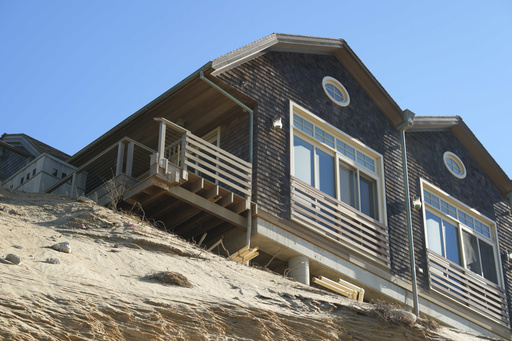
WELLFLEET, Mass. — The encroaching waters of Cape Cod Bay are threatening a luxurious brown residence that sits precariously atop a sandy bluff. The question is no longer if, but when, it will succumb to the relentless erosion.
The once expansive deck, which featured massive sliding doors leading to picturesque views of the bay, has now been transformed into a barricade of flimsy wooden slats. This makeshift barrier serves to prevent any unfortunate accidents that could see individuals tumbling 25 feet down to the beach below.
The previous owner was aware of the impending danger and took measures to mitigate the situation before entering into a protracted disagreement with the local authorities. He dismantled the deck and several parts of the home, including a small tower that housed the master suite. Eventually, the property was sold to a salvage company which has indicated it will not finance any necessary remediation work.
Local officials express concern that a collapse of the residence could impose significant damage to the biological beds in their harbor, which are crucial for the local oyster farming industry, a highly valued asset in New England. A report commissioned by the town has warned that if preventative measures are not undertaken, the sprawling 5,100-square-foot dwelling could plunge into the bay as soon as three years from now, potentially even sooner.
The situation serves as a stark representation of the vulnerabilities related to coastal development on the Cape, especially in light of climate change that has exacerbated sea-level rise in recent years.
“The dynamics of the Cape have always been in flux,” remarked John Cumbler, a former environmental history professor serving on the Wellfleet Conservation Commission. “The sands are continuously shifting.”
The house was originally constructed in 2010 on the bay side of the Cape Cod peninsula. In 2018, its initial owners, Mark and Barbara Blasch, sought permissions to construct a 241-foot seawall to combat erosion. However, the local conservation commission, comprised of seven volunteer members, voted against the proposal, citing potential negative consequences to the beach ecosystem and the transport of nutrients in the water. They also raised doubts about whether the seawall would successfully protect the property.
As the property is located within the boundaries of Cape Cod National Seashore, the National Seashore Administration backed the commission’s decision, emphasizing the critical environmental significance of the area, which is home to vital habitats and valued shellfish industries. The Blasches subsequently appealed the decision in state district court but ultimately lost. An appeal to the state’s Superior Court remains ongoing.
In 2022, a New York attorney named John Bonomi purchased the house for $5.5 million, despite acknowledging uncertainty regarding its future. Bonomi’s legal team has chosen not to comment on the situation.
Recent findings from a report prepared for Wellfleet by Bryan McCormack, a coastal processes expert from the Woods Hole Oceanographic Institution Sea Grant, indicate that the bluffs are experiencing erosion rates between 3.8 to 5.6 feet annually. The report eerily predicts that a structural failure could occur in three years or likely even sooner.
Furthermore, the report warns that such a collapse could introduce debris into Wellfleet Harbor, jeopardizing the region’s distinct oysters, which typically require two to three years to reach maturity. “The house contains a significant amount of fiberglass insulation and toxic materials,” Cumbler noted. “If these contaminants infiltrate Wellfleet Harbor, it could threaten the oyster trade, which is pivotal to our local economy aside from tourism.”
Bonomi initially approached the commission in October, expressing awareness of the property’s existential risks and promising a detailed plan by January regarding how to address the issue. “We requested a strategy for its removal from harm,” Cumbler stated. However, when that plan was expected to be presented at a January meeting, Bonomi’s attorney informed the town that the house had been sold to CQN Salvage, a relatively new company that would not be financially responsible for remediation efforts.
During a January commission meeting, the attorney for CQN Salvage disclosed that the estimated minimum cost to remove the house was around $1 million. In a moment of inquiry, Lecia McKenna, the town’s conservation agent, pressed Moore, “So, you plan to do nothing and permit it to collapse into the water?” To which he replied, “I intend to request that you prevent it from falling.”
Consequently, the commission agreed to extend the compliance deadline to June 1.
Currently, the town’s residents find themselves in a state of anxious anticipation. An on-site visit earlier revealed that 20 mph winds were adversely affecting the bluffs, with evidence of sand losing its foothold. Over the last 90 years, the sea level at Falmouth has increased by 11 inches, with an accelerating pace noted in recent times.
According to McCormack, while it’s challenging to ascertain the direct attribution of a single property’s erosion to climate change, Cape Cod has faced significant erosion for millennia. Still, he emphasized that since 2014, the bluffs have receded by over 54 feet, and the erosion rates seen in the last decade have noticeably surpassed the long-term averages recorded by the Massachusetts Office of Coastal Zone Management.

